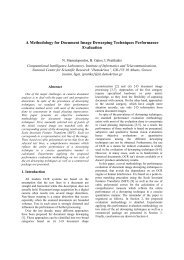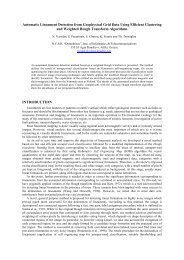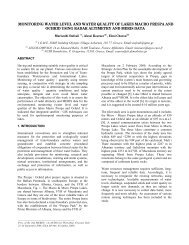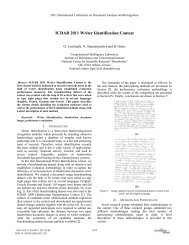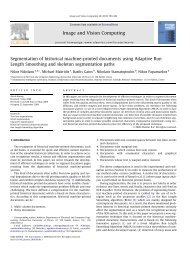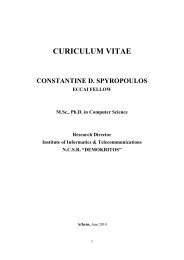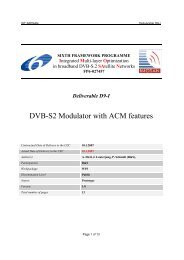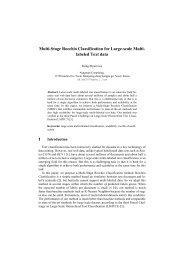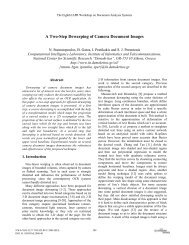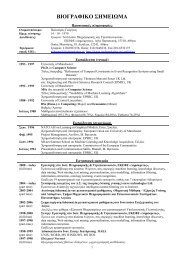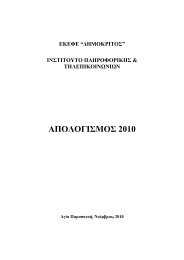TMS320C6713B Floating-Point Digital Signal Processor (Rev. A)
TMS320C6713B Floating-Point Digital Signal Processor (Rev. A)
TMS320C6713B Floating-Point Digital Signal Processor (Rev. A)
Create successful ePaper yourself
Turn your PDF publications into a flip-book with our unique Google optimized e-Paper software.
SPRS294 − OCTOBER 2005<br />
electrical characteristics over recommended ranges of supply voltage and operating case<br />
temperature † (unless otherwise noted)<br />
VOH<br />
VOL<br />
II<br />
IOZ<br />
IDD2V<br />
IDD3V<br />
PARAMETER TEST CONDITIONS MIN TYP MAX UNIT<br />
High-level output All signals except SCL1, SDA1,<br />
voltage<br />
SCL0, and SDA0<br />
IOH =MAX 2.4 V<br />
Low-level output<br />
voltage<br />
Input current<br />
Off-state output<br />
current<br />
Core supply current‡<br />
I/O supply current‡<br />
All signals except SCL1, SDA1,<br />
SCL0, and SDA0<br />
IOL = MAX 0.4 V<br />
SCL1, SDA1, SCL0, and SDA0 IOL = MAX 0.4 V<br />
All signals except SCL1, SDA1,<br />
SCL0, and SDA0<br />
SCL1, SDA1, SCL0, and SDA0<br />
All signals except SCL1, SDA1,<br />
SCL0, and SDA0<br />
SCL1, SDA1, SCL0, and SDA0<br />
VI = VSS to DVDD<br />
VO = DVDD or 0 V<br />
GDP/ZDP, CVDD = 1.4 V,<br />
CPU clock = 300 MHz<br />
GDP/ZDP/PYP, CVDD =<br />
1.26 V, CPU clock = 225<br />
MHz<br />
GDPA/ZDPA, CVDD =1.26V<br />
CPU clock = 200 MHz<br />
GDPA/ZDPA/PYP/ PYPA<br />
CVDD =1.2 V CPU clock =<br />
200 MHz<br />
PYPA, CVDD =1.2 V CPU<br />
clock = 167 MHz<br />
DVDD = 3.3 V, EMIF speed<br />
= 100 MHz<br />
±170 uA<br />
±10 uA<br />
±170 uA<br />
±10 uA<br />
945 mA<br />
625 mA<br />
560 mA<br />
565 mA<br />
480 mA<br />
75 mA<br />
Ci Input capacitance 7 pF<br />
Co Output capacitance 7 pF<br />
† For test conditions shown as MIN, MAX, or NOM, use the appropriate value specified in the recommended operating conditions table.<br />
‡ Measured with average activity (50% high/50% low power) at 25°C case temperature and 100-MHz EMIF. This model represents a device<br />
performing high-DSP-activity operations 50% of the time, and the remainder performing low-DSP-activity operations. The high/low-DSP-activity<br />
models are defined as follows:<br />
High-DSP-Activity Model:<br />
CPU: 8 instructions/cycle with 2 LDDW instructions [L1 Data Memory: 128 bits/cycle via LDDW instructions;<br />
L1 Program Memory: 256 bits/cycle; L2/EMIF EDMA: 50% writes, 50% reads to/from SDRAM (50% bit-switching)]<br />
McBSP: 2 channels at E1 rate<br />
Timers: 2 timers at maximum rate<br />
Low-DSP-Activity Model:<br />
CPU: 2 instructions/cycle with 1 LDH instruction [L1 Data Memory: 16 bits/cycle; L1 Program Memory: 256 bits per 4 cycles;<br />
L2/EMIF EDMA: None]<br />
McBSP: 2 channels at E1 rate<br />
Timers: 2 timers at maximum rate<br />
The actual current draw is highly application-dependent. For more details on core and I/O activity, refer to the TMS320C6711D, C6712D, C6713B<br />
Power Consumption Summary application report (literature number SPRA889A2 or later).<br />
100 POST OFFICE BOX 1443 • HOUSTON, TEXAS 77251−1443



